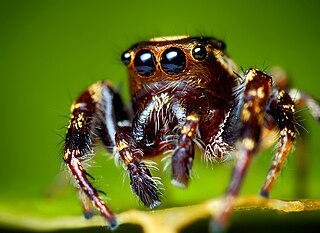
Standard anatomical terms of location are used to unambiguously describe the anatomy of animals, including humans. The terms, typically derived from Latin or Greek roots, describe something in its standard anatomical position. This position provides a definition of what is at the front ("anterior"), behind ("posterior") and so on. As part of defining and describing terms, the body is described through the use of anatomical planes and anatomical axes.

Pedipalps are the secondary pair of forward appendages among chelicerates – a group of arthropods including spiders, scorpions, horseshoe crabs, and sea spiders. The pedipalps are lateral to the chelicerae ("jaws") and anterior to the first pair of walking legs.

Jumping spiders are a group of spiders that constitute the family Salticidae. As of 2019, this family contained over 600 described genera and over 6,000 described species, making it the largest family of spiders at 13% of all species. Jumping spiders have some of the best vision among arthropods and use it in courtship, hunting, and navigation. Although they normally move unobtrusively and fairly slowly, most species are capable of very agile jumps, notably when hunting, but sometimes in response to sudden threats or crossing long gaps. Both their book lungs and tracheal system are well-developed, and they use both systems. Jumping spiders are generally recognized by their eye pattern. All jumping spiders have four pairs of eyes, with the anterior median pair being particularly large.

Anyphaenidae is a family of araneomorph spiders, sometimes called anyphaenid sac spiders. They are distinguished from the sac spiders of the family Clubionidae and other spiders by having the abdominal spiracle placed one third to one half of the way anterior to the spinnerets toward the epigastric furrow on the underside of the abdomen. In most spiders the spiracle is just anterior to the spinnerets.

Eris is a genus of the spider family Salticidae. It is native to North and South America. As is typical for salticids, they are not defensive. While larger specimens could potentially bite, an envenomation would pose no danger to a human.

The coastal plain cooter or Florida cooter is a species of large herbivorous freshwater turtle in the genus Pseudemys.

The anatomy of spiders includes many characteristics shared with other arachnids. These characteristics include bodies divided into two tagmata, eight jointed legs, no wings or antennae, the presence of chelicerae and pedipalps, simple eyes, and an exoskeleton, which is periodically shed.

Carya floridana the scrub hickory, is a small tree native to the Southeast United States, where it is endemic to central Florida.
Ulmus americana var. floridana, the Florida elm, first described as Ulmus floridana by Alvan Wentworth Chapman in the 1860s, is smaller than the type, and occurs naturally in north and central Florida south to Lake Okeechobee.
This glossary describes the terms used in formal descriptions of spiders; where applicable these terms are used in describing other arachnids.

Caponiidae is a family of ecribellate haplogyne spiders that are unusual in a number of ways. They differ from other spiders in lacking book lungs and having the posterior median spinnerets anteriorly displaced to form a transverse row with the anterior lateral spinnerets. Most species have only two eyes, which is also unusual among spiders. A few species of Caponiidae variously have four, six or eight eyes. In some species the number of eyes will increase when the spiderling changes its skin as it grows towards adulthood.

Progradungula otwayensis, commonly known as the odd-clawed spider, is a species of cribellate spider endemic to the Great Otway National Park of Victoria, Australia. It is one of only two species in the gradungulid genus Progradungula.

Bassaniana, commonly called bark crab spiders, is a widespread genus of crab spiders that was first described by Embrik Strand in 1928.

Bassaniana decorata is a species of spider in the family Thomisidae, found in Russia, China, Korea and Japan.
Bassaniana ora is a species of spider in the genus Bassaniana, native to Korea.

Bassaniana versicolor is a species of spiders in the genus Bassaniana, native to North America.

Metacyrba floridana is a species of spider in the family Salticidae, the jumping spiders. It is native to the United States and has been reported from the following states: Arizona, Florida, Georgia, Louisiana, Mississippi, and Texas.
Castianeira floridana is a species of true spider in the family Corinnidae. It is found in the United States and Cuba.

Eris floridana is a species of jumping spider. It is found in the United States.















